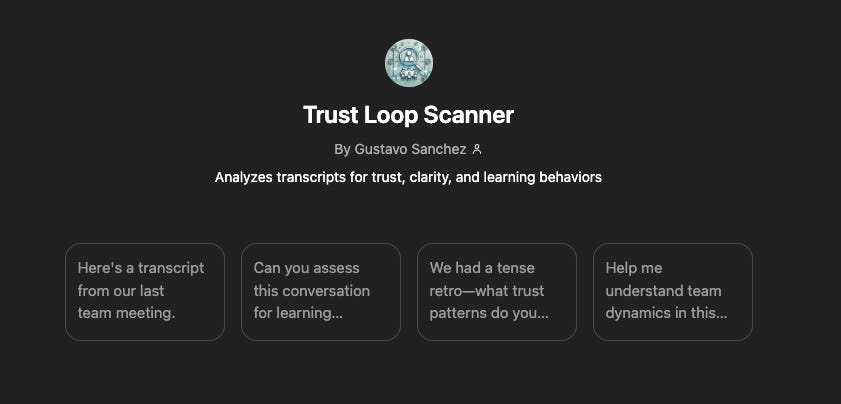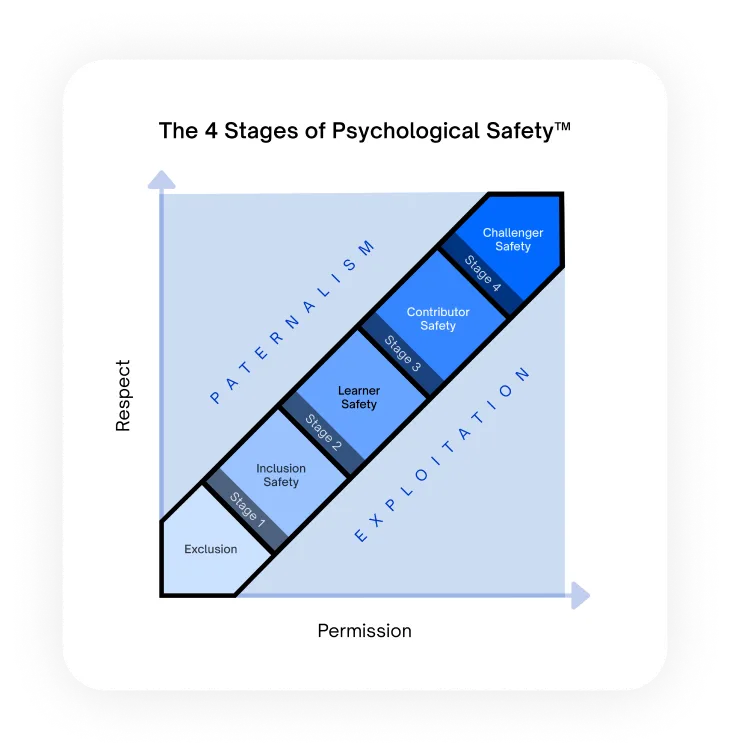Your Org Might Be Shipping. But Is It Learning, Fast?
Why psychological safety, and not tools, drives learning velocity.
We had just finished an experiment sprint on our lifecycle marketing automation team. A few A/Bs. A funnel tweak. A pricing flow test. Everything shipped fast. Results came back just as fast. The metrics didn’t move.
But that wasn’t the failure. The failure came in the retro.
In the postmortem, someone asked the question we always ask:
“What happened?”
Everyone had a theory.
But no one said what we were all actually thinking.
The conversation bent around the truth.
We softened our takes, redirected to safer variables, and buffered real insight with polite analysis.
It stayed just beneath the surface, not because we didn’t care, but because it didn’t feel safe to name it.
That’s where learning breaks.
Because you can still ship.
You can run retros.
You can even call yourself a learning org.
And still be stuck.
Over time, you start mistaking throughput for clarity.
Decisions get made, but no one remembers why.
People attend meetings, but with less and less to say.
Mistakes repeat themselves, with slightly different packaging.
“Most organizations learn poorly. The way they are designed and managed, the way people's jobs are defined, and, most importantly, the way we have all been taught to think and interact… create fundamental learning disabilities.”
— Peter Senge, The Fifth Discipline
The most dangerous part?
The system still looks like it’s working.
I’ve seen this pattern in large companies and small ones.
At Shopify. At Dropbox. In scrappy teams. In elite ones.
They’re thoughtful. They move fast. They care deeply.
What’s missing isn’t capability. Or intelligence.
It’s something quieter, and harder to spot.
A system that makes it risky to say what’s obvious.
A lack of psychological safety with enough strength to support the truth.
Let’s define it.
Psychological safety isn’t a cultural vibe or team-building byproduct. It’s a shared belief held by every team member that it’s safe to speak up, admit a mistake, ask a question, or offer a challenge without fear of embarrassment, rejection, or retribution.
It’s not comfort. It’s not consensus. It’s knowing that saying what you see, even if it's inconvenient, and it won’t quietly cost you later.
Amy Edmondson, who pioneered the concept, defined it as “a climate in which people are comfortable being themselves.” But in execution, it’s far more operational. It’s about how the system responds when the truth enters the room.
The 4 Stages of Psychological Safety, as outlined by Dr. Timothy R. Clark, was a foundational read for me. It cemented what I had intuitively felt for years, that learning velocity, creative risk-taking, and high trust cultures all depend on a system of permission, not just encouragement. His framework gave structure to those instincts, and backed them with the kind of research that leaders can use to operationalize trust, not just talk about it.
Clark’s model moves through four progressive conditions:
Inclusion Safety – feeling accepted and connected
Learner Safety – feeling safe to ask questions and grow
Contributor Safety – feeling trusted to make a difference
Challenger Safety – feeling free to challenge the status quo
Fast-learning teams aren’t just high output. They’ve designed systems where these four layers are present and protected.
This article on the 4 stages of psychological safety from Spill, I thought does a great job breaking the concept down
So why does it drive learning velocity?
Because learning isn’t an intellectual activity. It’s a behavioural one.
As summarized in The Science of Learning report by Deans for Impact,
“The measure of learning is behavior change, not just knowledge acquisition.”
Think about it. You can only course-correct if people feel safe enough to say, “We’re off-course.” You can only adapt fast if someone feels safe enough to ask, “Why are we doing this again?”
And you can only generate leverage from failure if the first reaction isn’t blame, but curiosity.
Here’s the causal chain:
Safety → Disclosure → Shared Insight → Ownership → Adaptation → Velocity
Break the chain at the start, if someone holds back, and the rest never happens.
Unlike tooling, this loop doesn’t scale with automation.
It scales with trust.

Tools vs. Safety: What really makes teams faster?
Most teams try to fix learning gaps with tools.
You’ve seen it. A new retro template. An “insights” channel in Slack. Quarterly feedback forms. Engagement surveys. Maybe even a pulse poll or two.
None of these things are inherently bad. But when they’re used in place of trust, they don’t solve the real problem, they just digitize the dysfunction. Because when people don’t feel safe, they don’t say what they really see. They say what sounds reasonable. They manage tone. They pick the safe answer. And the system congratulates itself for participation while the signal never moves.
A team with basic tools but high trust will outperform a team with perfect tooling and low safety. Not occasionally, consistently.
What does it actually look like when a team has it?
At Shopify, we eventually shifted to running async postmortems after every experiment sprint (at least in my teams). But we didn’t just collect answers, we designed the ritual to protect the insight itself.
Everyone wrote private reflections before seeing each other’s comments
No one spoke first, comments came first, anonymously
Feedback was reviewed by a neutral facilitator, not a stakeholder (we often asked our friends in UX)
Every insight needed a named follow-up, not just a “noted”
The result?
Truth surfaced. Decisions changed. People felt seen.
And the feedback loop wasn’t just faster, it was trusted.
That’s psychological safety in motion.
It didn’t come from culture decks.
It came from structural decisions that protected truth from power.
So what do you do with that?
It doesn’t start with a new retro format or another feedback tool. It starts by recognizing that trust isn’t a vibe or a leadership style, it’s a system condition. When people know they can surface what feels uncomfortable without social penalty, they stop holding back and start offering the kind of signal that actually moves the team forward. You don’t need dramatic moments. You need a system that quietly rewards truth and makes learning a shared responsibility, not a personal risk.
That shift changes everything. Instead of interpreting hesitation as disengagement, you begin to see it as a clue. Instead of assuming alignment from silence, you start looking for what hasn’t been said. When that kind of awareness becomes normal, when trust is structurally supported, not just hoped for, insight shows up earlier, and teams respond faster. And that’s when learning stops being a retrospective idea and starts becoming a competitive advantage.
Here’s what that looks like in practice:
1/ Own the silence before you try to fix it.
If you sense people are holding back, name it. Don’t spin it.
“I’ve noticed we don’t always name what’s not working. That’s on me. I want to change that.”
You don’t need vulnerability from your team. You need to model it first.
2/ Shift retros from review to reckoning.
Stop asking what happened.
Start asking what changed about how we think, what we missed, and what we’ll do next time.
“What did we assume and never validate?”
“What felt off, but we didn’t dig into?”
“What are we going to do differently because of this?”
Don’t just document insight. Assign it.
3/ Give insight a name, not just a ticket.
Every clear signal in a retro or review needs someone responsible for making sure it turns into a shift.
Too often, we treat feedback as input. But input without ownership is just noise.
Learning needs an owner, or it leaks.
4/ Make it easier to speak up than to stay quiet.
You don’t need psychological safety theory. You need systems that reward clarity and truth seeking more than consensus.
Start by listening for discomfort. And when someone challenges the status quo, back them up in real time.
If your team sees that honesty gets curiosity, not consequences, you’ll get more of it.
5/ Use structure to protect the truth from politics.
Don’t rely on courage. Use rituals.
Try GitLab’s async demos. Use Amazon’s six-pagers. Rotate who leads the retro. Create systems where the truth doesn’t need to fight for airtime.
A good system makes candor the default, not a personal risk.
6/ Look at who isn’t speaking.
If the same few voices dominate every conversation, your learning loop is incomplete.
Often, the people with the most useful insight have the most reasons to stay quiet.
New team members. ICs. People who’ve spoken up in the past and saw nothing change.
Ask yourself: “What does this system do to their voice?”
Because if it doesn’t amplify it, you’re not really learning. You’re just reinforcing what’s already comfortable.
When trust becomes part of the operating system, everything compounds.
When trust becomes part of the operating system, the energy of the team shifts. People stop managing impressions and start surfacing patterns. Feedback loops don’t just close, they create forward motion. The effort once spent navigating personalities or protecting status gets redirected into making the work stronger, faster, and clearer.
This isn’t about psychological safety as a leadership buzzword. It’s about engineering a system where learning can move faster than fear, where signal isn’t diluted by caution, and speed doesn’t come at the cost of silence. When that system is in place, teams don’t just execute. They adapt. And that’s the real advantage.
Want to know how your team is actually doing?
Try the Trust Loop Scanner: a free, GPT-powered audit tool I designed to create a tangible asset to help you.
Simple paste your last meeting transcript (please get permission and tell everyone about the exercise before hand), and get a breakdown of:
Your team’s Learning Culture Score
Missed insight patterns
Psychological safety breakdowns
And custom, role-specific actions to help your team learn faster
Built for leaders who want learning velocity, not just retros.
👉 Run your first audit

Further Fuel:
Recent articles I wrote on leadership that you may have missed.
On Making Better Decisions, Together
Why most growth teams don’t need more data, they need clearer upstream calls.Energy Debt: The Leadership Cost You’re Probably Ignoring
Burnout isn’t about bandwidth. It’s about unacknowledged drag in your org.Language as Leverage: How Better Words Build Better Orgs
A system breakdown in most teams starts with bad syntax.




Absolutely agree—psychological safety is such a game changer. When people feel safe to speak up and make mistakes, they learn and grow so much faster. It creates an environment where real collaboration and innovation can thrive.